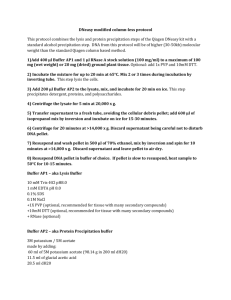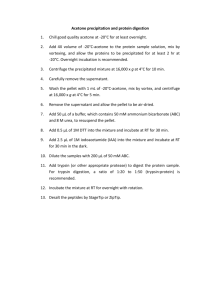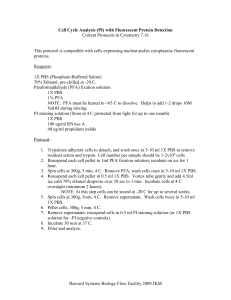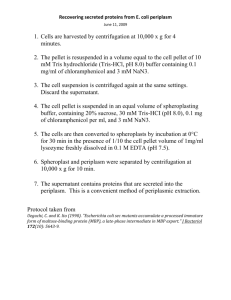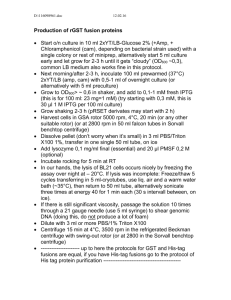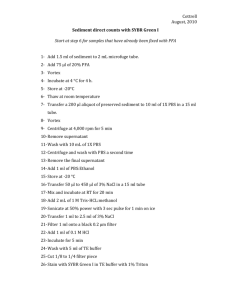STGCL.SWP.48.1_Protein purification from
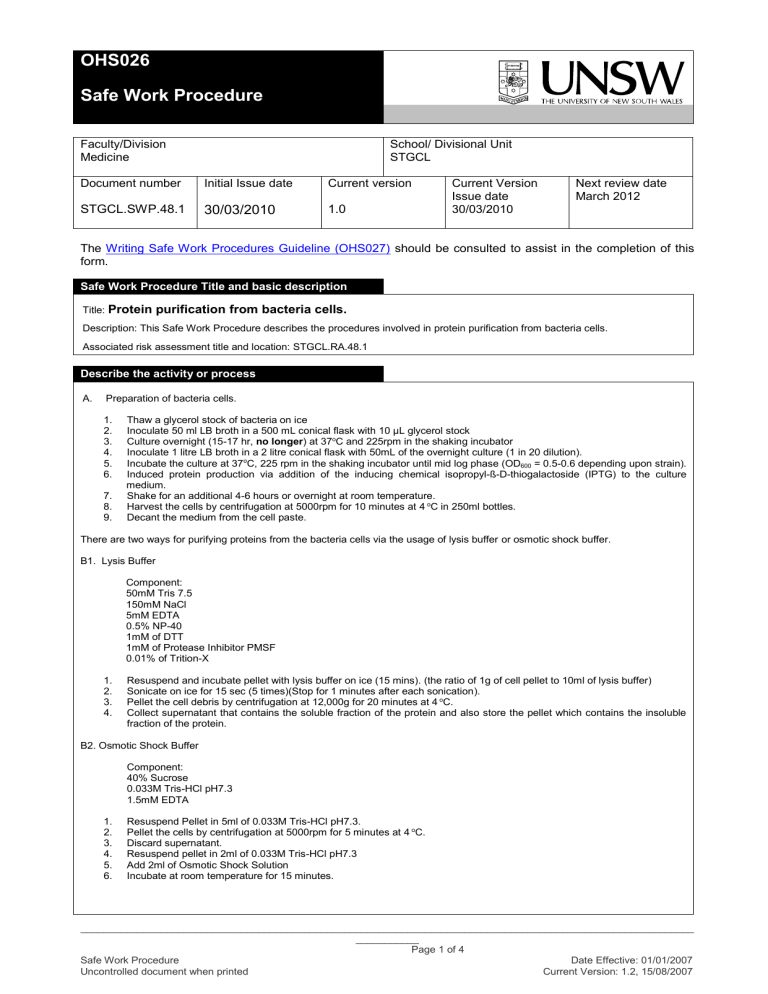
OHS026
Safe Work Procedure
Faculty/Division
Medicine
Document number
STGCL.SWP.48.1
Initial Issue date
30/03/2010
School/ Divisional Unit
STGCL
Current version
1.0
Current Version
Issue date
30/03/2010
Next review date
March 2012
The Writing Safe Work Procedures Guideline (OHS027) should be consulted to assist in the completion of this form.
Safe Work Procedure Title and basic description
Title:
Protein purification from bacteria cells.
Description: This Safe Work Procedure describes the procedures involved in protein purification from bacteria cells.
Associated risk assessment title and location: STGCL.RA.48.1
Describe the activity or process
A. Preparation of bacteria cells.
1. Thaw a glycerol stock of bacteria on ice
2. Inoculate 50 ml LB broth in a 500 mL conical flask with 10 µL glycerol stock
3. Culture overnight (15-17 hr, no longer ) at 37 o C and 225rpm in the shaking incubator
4. Inoculate 1 litre LB broth in a 2 litre conical flask with 50mL of the overnight culture (1 in 20 dilution).
5. Incubate the culture at 37 o
C, 225 rpm in the shaking incubator until mid log phase (OD
600
= 0.5-0.6 depending upon strain).
6. Induced protein production via addition of the inducing chemical isopropylß-D-thiogalactoside (IPTG) to the culture medium.
7. Shake for an additional 4-6 hours or overnight at room temperature.
8. Harvest the cells by centrifugation at 5000rpm for 10 minutes at 4 o C in 250ml bottles.
9. Decant the medium from the cell paste.
There are two ways for purifying proteins from the bacteria cells via the usage of lysis buffer or osmotic shock buffer.
B1. Lysis Buffer
Component:
50mM Tris 7.5
150mM NaCl
5mM EDTA
0.5% NP-40
1mM of DTT
1mM of Protease Inhibitor PMSF
0.01% of Trition-X
1. Resuspend and incubate pellet with lysis buffer on ice (15 mins). (the ratio of 1g of cell pellet to 10ml of lysis buffer)
2. Sonicate on ice for 15 sec (5 times)(Stop for 1 minutes after each sonication).
3. Pellet the cell debris by centrifugation at 12,000g for 20 minutes at 4 o C.
4. Collect supernatant that contains the soluble fraction of the protein and also store the pellet which contains the insoluble fraction of the protein.
B2. Osmotic Shock Buffer
Component:
40% Sucrose
0.033M Tris-HCl pH7.3
1.5mM EDTA
1. Resuspend Pellet in 5ml of 0.033M Tris-HCl pH7.3.
2. Pellet the cells by centrifugation at 5000rpm for 5 minutes at 4 o C.
3. Discard supernatant.
4. Resuspend pellet in 2ml of 0.033M Tris-HCl pH7.3
5. Add 2ml of Osmotic Shock Solution
6. Incubate at room temperature for 15 minutes.
___________________________________________________________________________________________________________
___________
Page 1 of 4
Safe Work Procedure
Uncontrolled document when printed
Date Effective: 01/01/2007
Current Version: 1.2, 15/08/2007
Describe the activity or process
7. Pellet the cells by centrifugation at 5,000g for 10 minutes at 4 o C.
8. Discard supernatant.
9. Add 1ml of ice-cold 1mM MgCl
2
.
10. Incubate on ice for 10 minutes.
11. Pellet the cell debris by centrifugation at 12,000g for 10 minutes at 4 o C.
12. Collect supernatant that contains the soluble fraction of the protein and also store the pellet which contains the insoluble fraction of the protein.
D. Procedures for purification of tagged fusion proteins (c-Myc is used as an example).
A. Column Set Up
1. Place the empty chromatography column on a firm support.
2.
3.
Rinse the column with PBS.
Allow the buffer to drain from the column and leave residual PBS in the column to aid in packing the Anti c-Myc
Agarose conjugate.
B. Packing the Column
1.
2.
Thoroughly suspend the vial of c-Myc Agarose conjugate to make a uniform suspension of the beads.
Immediately transfer the desired volumn to the column. Allow the agarose bed to settle.
C. Washing the Column
Wash the resin with three sequential aliquots of 0.1M ammonium hydroxide, pH 11 to 12, followed by three sequential aliquots of PBS (ratio of 1 volume of beads to 5 volume of ammonium hydroxide/PBS). Avoid disturbing the agarose bed while loading.
D. Binding c-Myc tagged fusion protein to the column
1.
2.
3.
Load the lysate on the column under gravity flow.
Collect the “flow through” of unbound protein.
Wash the column with PBS until OD
280
=0.01.
E. Elution of c-Myc tagged fusion proteins
Elute the bound c-Myc tagged fusion protein from the column with 10 x 1ml aliquots of 0.1M ammonium hydroxide at pH
11 to 12 into vials containing 3050µl of 1N acetic acid for neutralization.
C. Procedure for preparation of tagged fusion proteins for SDS-Page. (c-myc is used as an example).
1. Add 50µl of the 1:1 suspension of the Anti-c-Myc Agarose conjugate to a microcentrifuge tube or a spin-column.
2. Allow the resin to settle by a short spin. Discard the liquid.
3. Wash the resin 5 times with 1ml PBS
4. Add bacterial lysat e to the settled resin. Bring the volume to at least 200µl with PBS.
5. Incubate for 1.5 hours on an orbital shaker at 4 o C.
6. Wash the resin 4 times with 1ml of PBS.
7. After the final wash, aspirate the supernatant and leave 10µl above the beads.
8. Add 50 µl 2X SDS sample buffer. Cap the tube securely and incubate 5 minutes at 95 o C.
9. Vortex then centrifuge for 5 seconds.
10. The supernatant which contains the protein of interest can be analyze by SDS-PAGE.
___________________________________________________________________________________________________________
___________
Page 2 of 4
Safe Work Procedure
Uncontrolled document when printed
Date Effective: 01/01/2007
Current Version: 1.2, 15/08/2007
List all resources required including plant, chemicals, personal protective clothing and equipment, etc
Chemicals:
Glycerol Stock of bacteria of interest
isopropylß-D-thiogalactoside (IPTG)
Lysis Buffer
Component (in 50ml total volume):
50mM Tris 7.5
150mM NaCl
5mM EDTA
0.5% NP-40
1mM of 1M DTT
1mM of Protease Inhibitor PMSF
0.01% of Trition-X
Osmotic Shock Buffer
Component (in 100ml total volume):
40% Sucrose
0.033M Tris-HCl pH7.3
1.5mM EDTA
1mM MgCl
2
Empty chromatography column
Anti c-Myc Agarose conjugate
Phosphate Buffer Saline (PBS)
0.1M Ammonium Hydroxide
1M Acetic Acid
Plant:
Class I Biohazard Safety Cabinet
Conical Flask
Orbital Shaking Incubator
Minispin Eppendorf Centrifuge
Centrifuge Hermle Z513K
Personal Protective Clothing:
Wear suitable protective clothing (i.e. long-sleeve gown), latex gloves, and eye protection.
List potential hazards and risk controls including specific precautions required
Hazards: Handling of bacteria culture outside a Biohazard Safety Cabinet risks generating aerosol particles which may be inhaled or ingested.
Risk Controls: Conduct bacterial work in a Biohazard Safety Cabinet. Wear suitable protective clothing (i.e. long-sleeve gown),
latex gloves, and eye protection.
Hazards: Handling of Dithiothreitol (DTT) which are irritant to eyes. Toxic by inhalation, in contact with skin and if swallowed.
Risk Controls: MSDSs are available. Wear suitable protective clothing, goggles and gloves.
Hazards: Handling of Ammonium Hydroxide which Causes burns. Harmful by inhalation or swallowed or absorbed by skin.
Risk Controls: MSDSs are available. Wear suitable protective clothing , goggles and gloves.
Hazards: Handling of NP-40 which is harmful if swallowed and risk of serious damage to eyes.
Risk Controls: MSDSs are available. Wear suitable protective clothing, goggles and gloves to prevent contact with eyes and
skin.
Hazards: Handling of Isopropylß-D-thiogalactoside (IPTG) which is highly flammable. Repeated exposure may cause skin
dryness or cracking.
Risk Controls: MSDSs are available. Wear suitable protective clothing, goggles and gloves.
Hazards: Handling of Protease Inhibitor PMSF which is harmful and irritant to respiratory system and skin.
Risk Controls: MSDSs are available. Wear suitable protective clothing, goggles and gloves.
Hazards: Handling of Triton X-100 is harmful if swallowed and risk of serious damage of eyes.
Risk Controls: MSDSs are available. Wear suitable protective clothing, goggles and gloves.
___________________________________________________________________________________________________________
___________
Page 3 of 4
Safe Work Procedure
Uncontrolled document when printed
Date Effective: 01/01/2007
Current Version: 1.2, 15/08/2007
List emergency shutdown instructions
After inhalation: In case of unconsciousness place patient stably in side position for transportation.
After skin contact: Immediately wash with soap, water and rinse thoroughly.
After eye contact: Rinse opened eye for several minutes under running water.
After swallowing: If symptoms persist consult doctor.
List clean up and waste disposal requirements
All waste must be collected and disposed as chemical waste.
Recommended cleansing agents: 80% (v/v) of ethanol, if necessary together with cleansing agents.
List legislation, standards and codes of practice used in the development of the SWP
Australian/New Zealand Standard, Safety in Laboratories Part 3: Microbiological aspects and containment facilities 2002
(AS/NZS 2243.3: 2002)
MSDSs for relevant chemicals.
Supervisory approval, training, and review
Supervisor: Prof. Beng H. Chong Signature:
Supervisor:
Supervisor:
Supervisor:
Signature:
Signature:
Signature:
Supervisor: Signature:
Plant custodian: Prof. Beng H. Chong Signature
List competency required – qualifications, certificates, licencing, training - eg course or instruction:
UNSW PC-2 Training
UNSW OGTR Induction
STGCL PC-2 Induction
SWP review date: March 2012 Responsibility for SWP review: Jaa Y. New
___________________________________________________________________________________________________________
___________
Page 4 of 4
Safe Work Procedure
Uncontrolled document when printed
Date Effective: 01/01/2007
Current Version: 1.2, 15/08/2007
